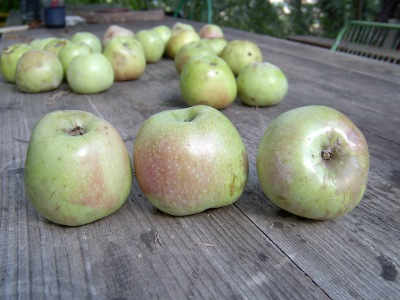︎︎︎ MELA CONVENTINA

Le piante madri sono state ritrovate nella zona di Gubbio (PG), da dove probabilmente ha preso origine. Veniva coltivata diffusamente in questa zona, ma è anche conosciuta nelle limitrofe aree di Pietralunga (PG) e nelle vicine Marche nel comune di Cantiano (PU) dove prende il nome di Comentina. E’ un’ottima varietà autunnale, apprezzata per la sua serbevolezza e la sua resistenza alle manipolazioni e al trasporto. L’albero è molto vigoroso e rustico, a chioma espansa, è a volte anche assurgente; produce in maniera alternata, fiorisce in epoca medio tardiva. L’albero è di notevole pregio paesaggistico.
Il frutto è medio grande, di forma oblunga con caratteristico restringimento verso la parte della cavità calicina. Il peduncolo è lungo inserito in cavità ampia, mediamente profonda. La cavità calicina è ampia e molto profonda. La buccia è fine, liscia, di colore verde giallognolo, con numerose lenticelle, leggermente rugginose. La polpa è bianca, acidula, aromatica e croccante, di ottima qualità. Viene raccolta tradizionalmente in ottobre e si conserva in fruttaio fino alla primavera successiva.
La Conventina è molto nota nella zona di Gubbio ed apprezzata da molto tempo, sia da consumo fresco che da cottura. Nella letteratura scientifica del secolo scorso e dell’inizio di questo secolo, fino agli anni ’40, ne viene ancora consigliata la coltivazione insieme alle varietà nazionali più note.
The mother plants were recovered in the Gubbio (Perugia) area, where it may have originated. It was commonly cultivated in this area but it is also known in the bordering areas of Pietralunga (Perugia) and in the Cantiano (Pesaro-Urbino) area in the nearby Marche where it is named comentina. It is a superb autumn variety, valued for its storing capability and its resistance to damage from handling and transportation. The tree is very vigorous and hardy, with a spreading but at times also compressed crown. It crops every other year and blooms mid-to late season. The tree is highly praised for its landscaping value. The fruit is medium-large with an oblong-conical form. The stem is long and inserted in a wide and moderately deep cavity. The calyx is wide and very deep. The skin is thin, smooth, a green-yellowish color and with numerous, slightly russeted lenticels. The flesh is white, slightly sour, aromatic, crisp and of very good quality. It is traditionally harvested in October and keeps in the fruit-house until the following spring. The conventina apple is very well known in the Gubbio area and has been appreciated for a long time, both as a fresh fruit and as a culinary one. The scientific literature from the 1800’s up until 1940 suggests that it be planted alongside better-known national varieties. In the past, to keep these apples and preserve their scent a curious system was adopted: the fruit would be placed in a case with elderberry flowers that had previously been dried in the shade.